Mad Hedge Technology Letter
August 14, 2023
Fiat Lux
Featured Trade:
(MACRO RISKS CLOUD THE PICTURE)
(AAPL), (NVDA), ($COMPQ)

Mad Hedge Technology Letter
August 14, 2023
Fiat Lux
Featured Trade:
(MACRO RISKS CLOUD THE PICTURE)
(AAPL), (NVDA), ($COMPQ)

The momentum signals that tech shares ($COMPQ) are still working themselves out and need more time to stomach Fitch’s debt downgrade.
Unfortunately, it hasn’t been a one-day dip buying opportunity and this month has been quite abysmal for the tech sector.
Just look at Apple which lost about 10% in value. That’s almost unheard of in today’s day and age.
Many investors are still recalibrating what it means to be on the end of a stunning sudden downgrade for the biggest economy in the world.
Making matters worse, the empirical data is starting to really show that China is teetering on the edge.
Centrally planned economies can have their time in the sun, but eventually, that system blows up as inefficiencies become a doom loop with no end.
There is a good chance at this point in his leadership that Chinese Communist Party Chairman Xi cannot get the right information about what is going on in China because the ranks have been solidified by cadres that leech off the system.
China could mean another leg down to close off the year instead of the relief rally that is poised to lift us back from the short-term weakness.
The Nasdaq index has dropped 4.2% this month, with top tech companies like Nvidia on the brink of 10% decreases.
Even Microsoft, despite its advancements in AI and partnership with OpenAI, has seen a 4% drop in August. Google has also shed 2.1%.
However, one tech giant that has been able to maintain a positive trajectory is Amazon, with its stock up 4% for the month.
This may be due to the company closely monitoring the productivity of employees returning to the office, as increased productivity can lead to higher profits.
The decrease in tech stocks coincides with the 10-year Treasury yield rising from approximately 3.95% in late July to above 4.1% currently.
Some signals suggest that yields may still go up and Fed futures reflect this with around a 35% chance the Fed will hike another .25% to 5.50%.
We could find us swiveling from the soft landing is complete to a “higher (yields) for longer” pivot which is effectively negative for short-term positive price action in tech stocks.
It’s entirely plausible that yields could retest the highs from 2022, based on the chart and recent trends.
This could spell bad news for tech investors, as tech stocks typically do not perform well in an environment of elevated yields. Higher borrowing costs, more attractive returns on cash, and increased scrutiny of future growth are among the challenges that tech companies face when interest rates rise.
However, the tech story is still intact albeit it a substantial amount more fragile than in early 2023.
The pain trade will be higher, but the fragility exposes itself to quicker external risks than before that could topple the market swiftly.
The United States has nobody but themselves to blame after issuing a mountain of debt and it’s largely true that when China sneezes, the world catches a cold.
Tech shares will be confronted with these two rising risks for the foreseeable future.
Best case scenario will see tech grinding higher into year-end, and don’t expect any gaps up. The low-hanging fruit has already been plucked from the vine this year.
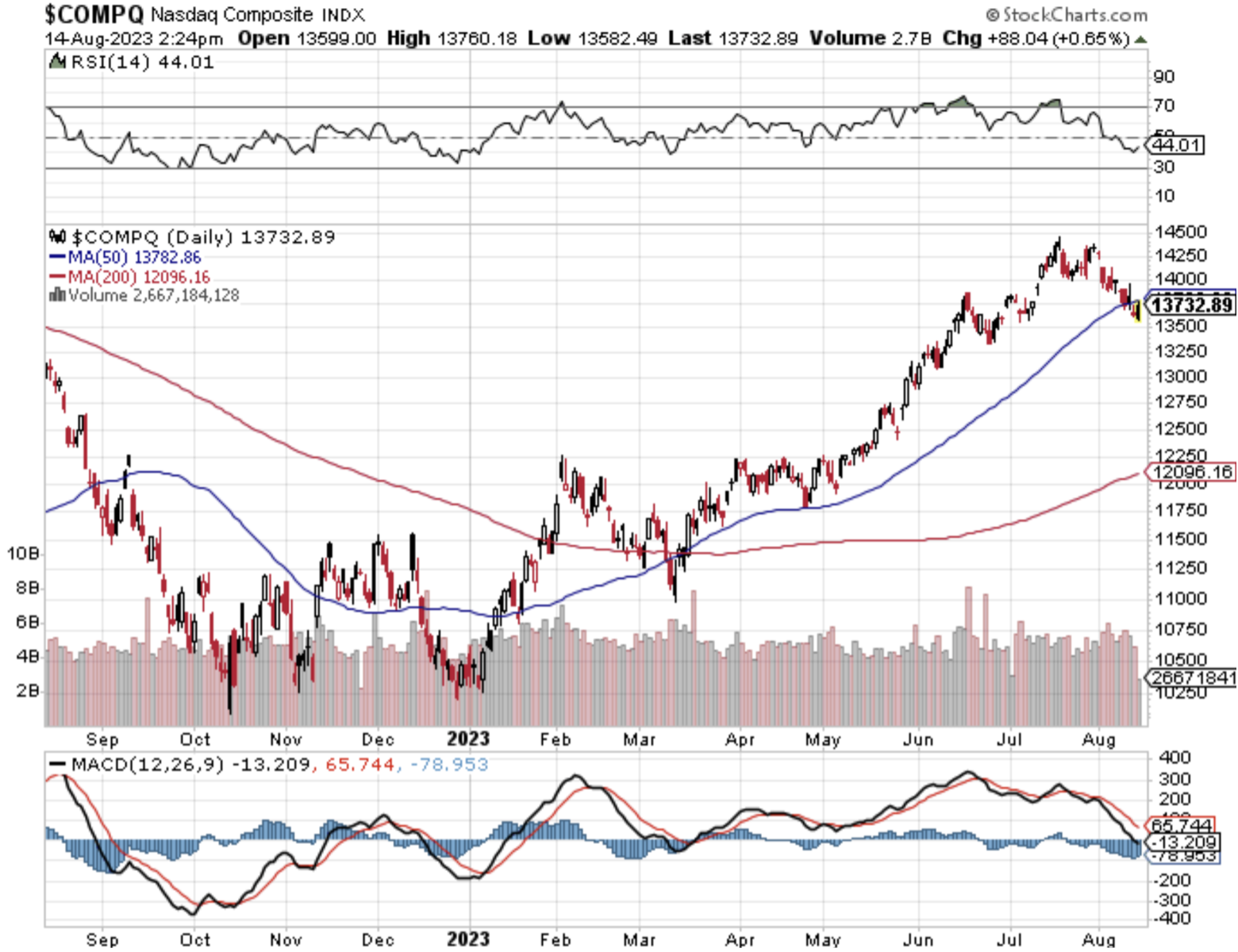
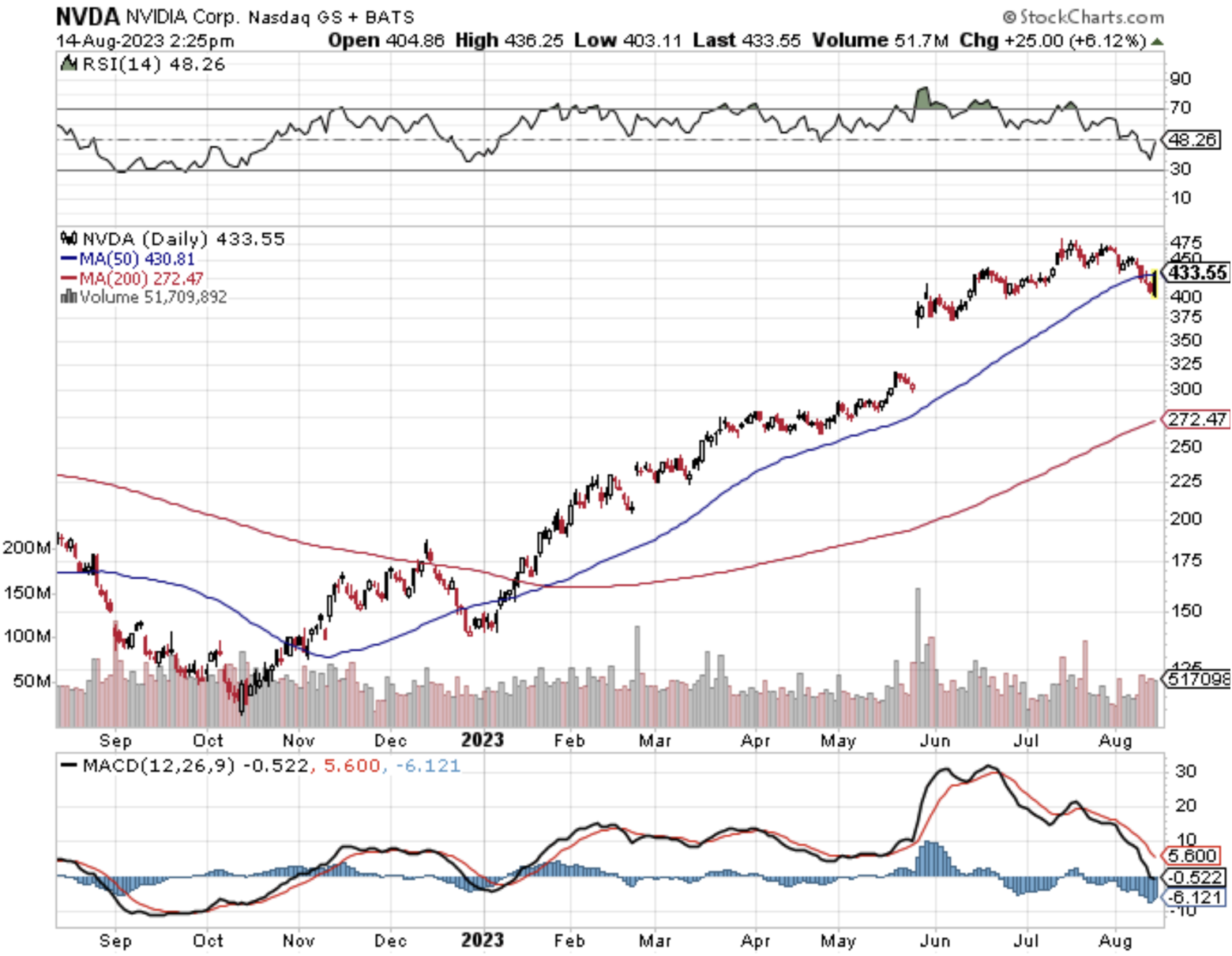
Mad Hedge Technology Letter
July 10, 2023
Fiat Lux
Featured Trade:
(THE YEN TAILWIND TO TECH STOCKS)
(JPY), ($COMPQ), (META), (ZM)

In the trader's guidebook of how to trade, it’s quite common to cement the nostrum "don’t fight the Fed" into one’s brain.
Many know this.
In 2022, this nostrum served traders quite well as interest rate increases left the tech market in the dust.
Major tech stocks ($COMPQ) from Meta (META) to small-cap Zoom Video Communications (ZM) fell flat on their face.
That was when "don’t fight the Fed" was the smart thing to do.
Fast forward to 2023 and the Fed is still marching towards more interest rate tightening, but astonishingly the opposite has happened, it has paid to fight the Fed this year.
Not only that, the tech-based Nasdaq has gone parabolic, delivering gains of already over 30% in just the first 7 months.
Anyone that hasn’t fought the Fed has been left bloody in the streets like a standard Parisian riot.
One piece of the puzzle that often gets overlooked is one major catalyst to this trade which is the Japanese yen carry trade.
This is how the trade has worked for many hedge funds this year.
Borrow in Japanese yen because the cost of borrowing is still puny compared to yields in Western countries.
Take that yen back over to the Western equity markets and pour them into stocks like Nvidia, Meta, Apple, Tesla, Microsoft, and Amazon.
The strategy has worked like clockwork and I know many traders that have made second and third fortunes off of the back of this trade so far this year.
Traders have boosted short positions on the yen as the currency moved steadily lower this year amid widening divergence between the Bank of Japan’s easy policy and aggressive hiking cycles for other central banks, notably in the US and Europe.
Talking about the Yen is timely as reports of lower US job numbers and increased Japanese wage gains triggered a one-day selloff in the dollar.
We won’t see a complete unwind of the yen carry trade just yet but the carry trade had gotten a little too long in the tooth, so this is profit-taking to readjust positioning.
If volatility stays high then it will continue to unwind, but if volatility stabilizes then the Japanese yen carry trade parade will continue unabashed.
The yen is one of the worst-performing Group-of-10 this year, reaching 145 per dollar last month, a level unseen since November.
What’s next?
Nothing has fundamentally changed.
The US isn’t going into a recession this year and even if credit card delinquencies are up and household net worth is struggling in America, it’s not enough to move the needle to deter the Japanese yen carry trade.
The mild pullback against the US dollar is in fact a golden opportunity for traders to pour back into the short Japanese yen trade.
As long as the Japanese yen remains weak, tech stocks won’t crack because this liquidity is the lifeblood to many tech stocks.
We have been crowbarred into this goldilocks environment of higher equities, higher bond yields, and now US housing is starting to bounce back.
The Nasdaq has been ironclad this year and even if I don’t think it will deliver another 30% to finish the year, the pain trader is higher in tech stocks, marginally higher in bond yields, higher in US housing, and short Japanese yen.
Until we receive some type of concrete confirmation that this pain trade is over, I expect to grind up in the aforementioned asset classes.
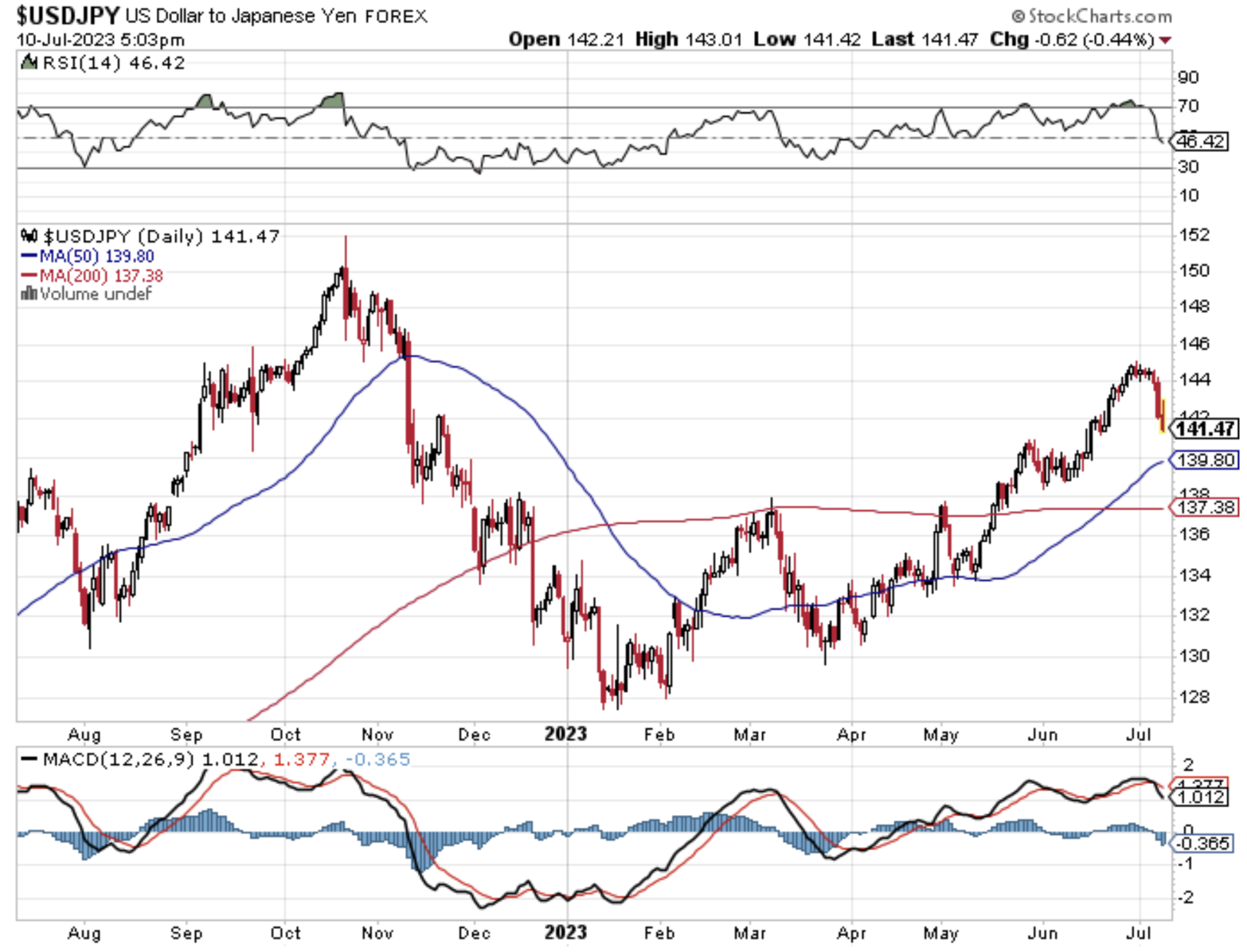

Mad Hedge Technology Letter
June 16, 2023
Fiat Lux
Featured Trade:
(THE SKINNY ON AI)
(CRM), (NVDA), (MSFT), ($COMPQ)

(CRM), (NVDA), (MSFT), ($COMPQ)
One misunderstanding about generative artificial intelligence is that it is advertised as the panacea that will cure the economy and global business in one second.
It’s not.
These types of technologies take time to absorb and integrate.
The type of hype surrounding AI feels like every tech company should 100X revenue next year.
That’s not going to happen right away.
It’s obviously going to be an incremental phenomenon instead of a parabolic rise.
People also seem to miss there will be a swath of AI failures that will disappear into the dustbin of history and everything in between.
Just because Nvidia (NVDA) and Microsoft (MSFT) are making hay during this hot money AI investor pandemonium, doesn’t mean all tech companies will.
In the long term, access to high-quality artificial intelligence will unlock a long-term productivity miracle.
The United States economy is suffering from a bout of unproductivity as young workers mostly spend their time perusing Instagram than tangibly delivering results.
Moving a finger is a hard slog these days for Generation Z.
The net result is poorly trending productivity gains.
Productivity growth in the US has been a paltry 1%.
This week alone brought two examples of generative AI's potential for economic output.
First, a new McKinsey study identified 63 generative AI use cases spanning 16 business functions that could unleash $2.6 trillion to $4.4 trillion in economic benefits annually.
The same study found that generative AI could perform each of more than 2,100 detailed work activities such as communicating with others about operational plans.
Generative AI has the potential to change the anatomy of work, augmenting the capabilities of individual workers by automating some of their individual activities.
Current generative AI and other technologies have the potential to automate work activities that absorb 60 to 70 percent of employees’ time today.
Meanwhile, software company Salesforce (CRM) launched its new GPT enterprise products designed to boost worker productivity.
The company introduced "AI Cloud" at a New York City investor day. Salesforce says its AI Cloud product will allow marketers to auto-generate personalized content for customers and developers to auto-generate code.
Salesforce employees also showed off coming AI functions in the workplace collaboration platform Slack.
It’s true that this AI wave is going to be the biggest that anyone has ever seen, but it will take time to get there.
I think there are meaningful lags in AI's impact. And the idea there will be a surge in economic growth in the next seven to ten years because of AI and technology.
It won’t happen in 2 or 3 years.
Goldman Sachs estimated recently that generative AI could expose the equivalent of 300 million jobs globally to automation over the next decade. That's a nice way of saying a person may lose their job to a robot.
AI could also eventually increase the annual global Gross Domestic Product (GDP) by 7%.
There is the thought that AI will make production faster and more voluminous but the quality and understanding will be poor. Just like all those online chat assistants that companies use. If you have a very specific question not covered by the FAQs they just spit back unhelpfulness.
The takeaway is that there will be winners and losers, but it will take time.
In many cases, the outsized winner is someone we have never heard of that brings something new to the table.
A critical part of this investor play is to avoid AI failures as well because there is bound to be a pile of body bags on the way to AI riches.
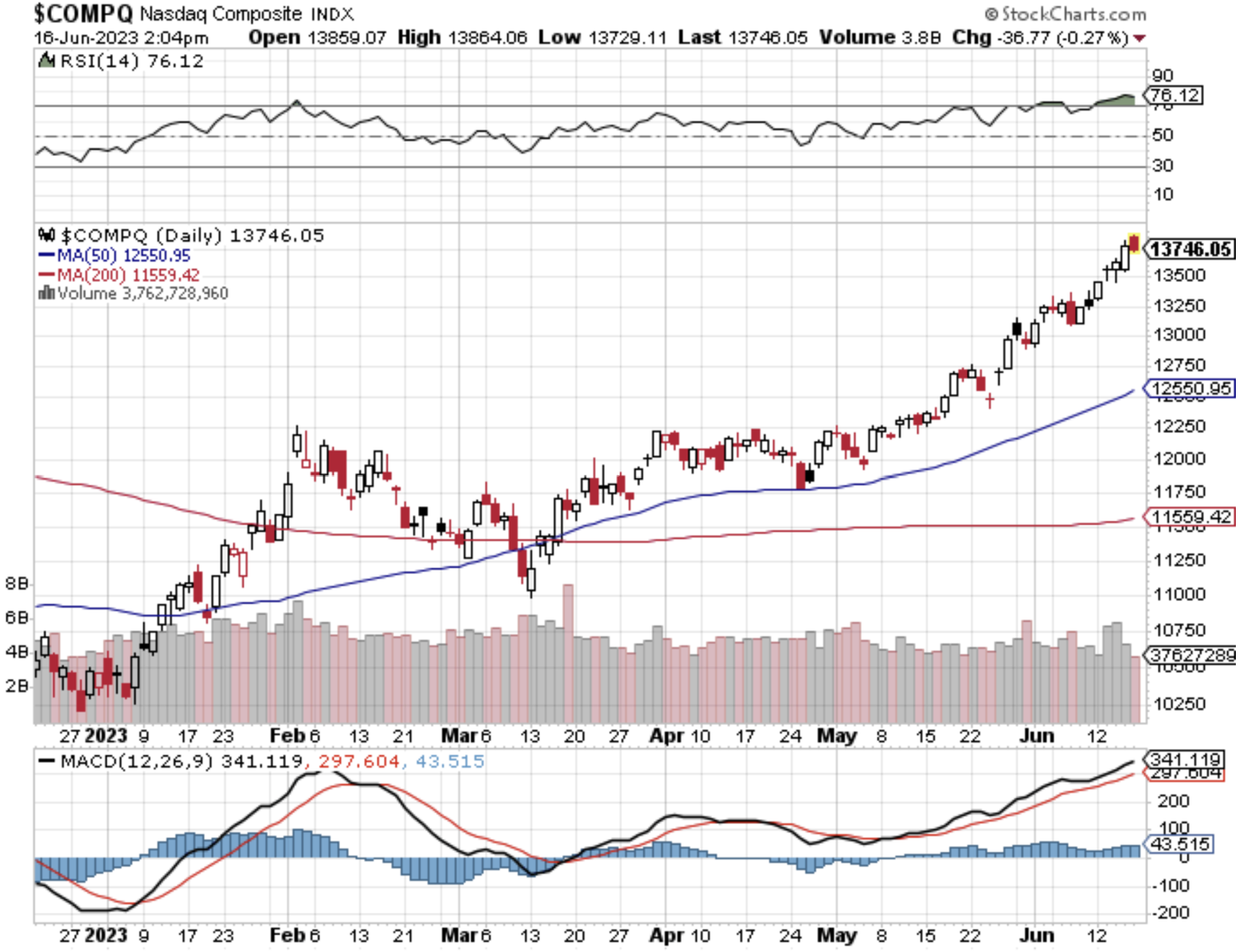
Mad Hedge Technology Letter
June 12, 2023
Fiat Lux
Featured Trade:
(GREEDFLATION WINS OUT)
($COMPQ), (UBER)

Tech companies are doing well and so is the overall stock market.
It doesn’t make sense to listen to all the doomsday personalities going on national TV to scare us out of making money.
Just zone them out – they are useless.
Back in the real world, the excellent performance is great news for holders of US tech stocks who have been carrying the load in 2023.
The tech-based Nasdaq index ($COMPQ) has returned 27% YTD and anyone betting on an “earnings recession” has had their head handed to them.
Mr. Market has continued to look through any risk presented and shrugging it off like it doesn’t matter.
We have been waiting for that recession which hasn’t arrived for almost 3 years now.
People will have to continue to wait too as the job numbers have been excellent.
Instead, we should focus on why tech companies are doing so well and what makes their balance sheets tick.
In a widespread industry survey, 89% of respondents said US companies have been raising prices in excess of their own costs since the pandemic began in 2020. Almost four out of five said that tight monetary policy is the right way to tackle profit-led inflation.
The surge in corporate markups cannot be understated and tech companies have done exceptionally well with Uber (UBER) rides more costly as just one little example among many.
Margins soared in the initial pandemic years, and have defied convention by remaining historically high since then.
The unique circumstances of the pandemic – severe supply constraints, followed by an unprecedented burst of stimulus-fueled demand – lie behind the widening of profit margins, which hit 70-year highs in the US.
Even if margins come down a little because customers start to balk at high prices, the price reductions will be most likely incremental.
Standard economic theory holds that profit margins are “mean-reverting’’ – in other words, they tend to be pulled back to normal levels. It’s supposed to work like this: An industry with high profits should attract new entrants, with increased competition forcing margins lower.
However, many tech companies are operating as de-facto monopolies in their subsector and possess an unprecedented amount of pricing power for the products they sell.
This has led to the idea more colloquially known as “greedflation.’’
Until a rising backlash against monopolies or oligopolies triggers buyer protests, the tech playbook should be to buy those companies that look most similar to monopolies.
Ultimately “greedflation’’ is great for holders of tech stocks and not necessarily good for US consumers.
Clearly, there is a profit honeymoon with the likes of big tech raking in the dough.
They can even push out aggressive and abstract products like the Apple VR headset for $3,500 per clip.
That’s not a defensive strategy as well as absorbing billions to develop the product.
Coupled with the lust for anything generative AI, the conflation with higher margins has triggered a momentous rally in tech stocks.
As we narrow down our paths for the rest of the year, a demonstrative easing cycle is setting up promising to catapult tech stocks another leg up from current levels.
The considers that inflation is dropping fast from 5% to 4% and projections could find us in the 3%-ish range in the next month or two which is a strong tailwind for tech stocks.
It’s hard to see where the sellers come in and I would continue to buy every small dip in every quality tech stock name.
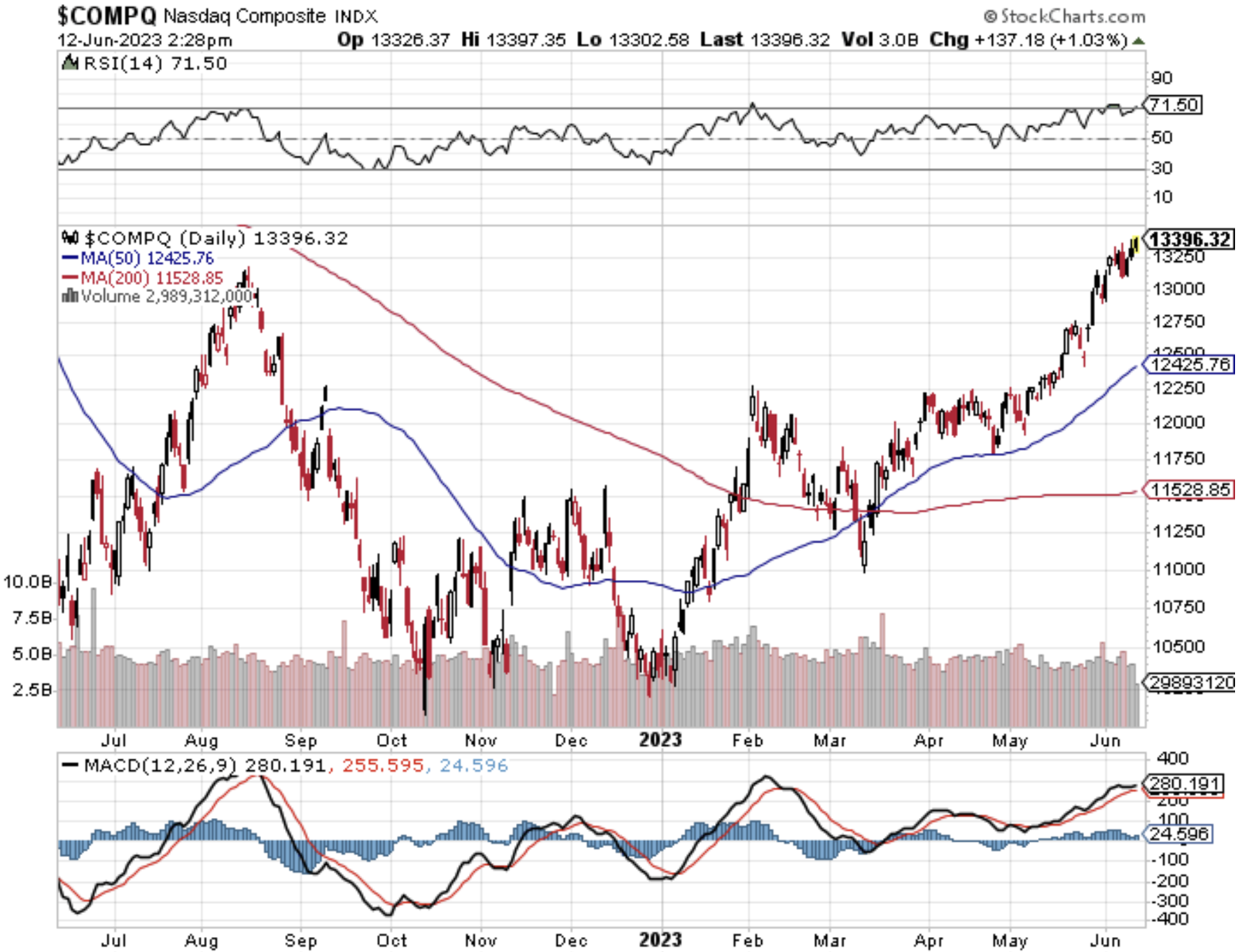
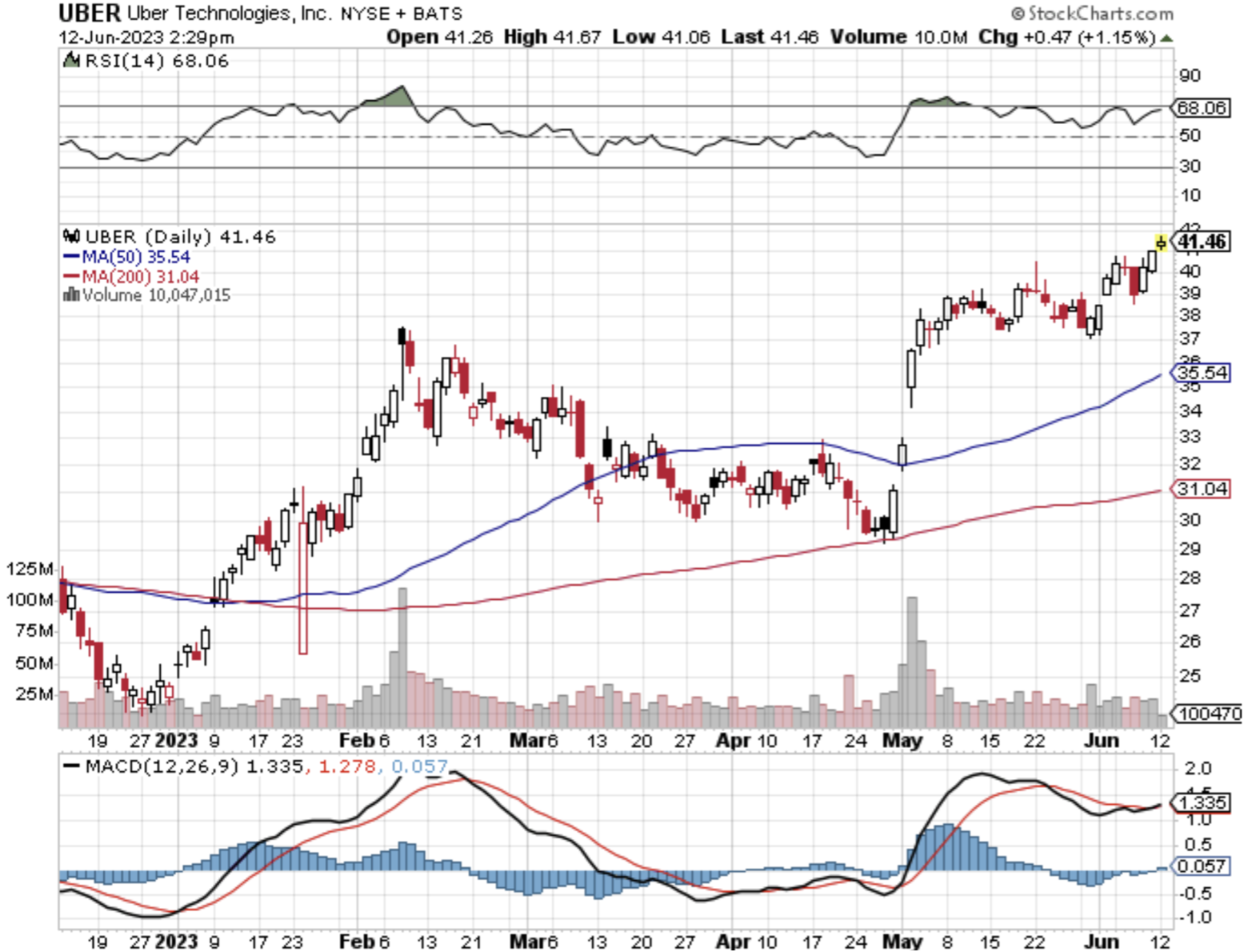
Mad Hedge Technology Letter
May 19, 2023
Fiat Lux
Featured Trade:
(DON’T COUNT OUT THE TECH SECTOR)
(GOOGL), (MSFT), (AMZN), ($COMPQ)

It’s no surprise that the technology industry led other sectors to the number of job cuts in 2022.
It found more than 150,000 tech workers received pink slips in the year, a 900% increase from 2021.
In 2023, tech layoffs continue throughout various firms, and let’s go through some of the prominent ones.
Microsoft (MSFT) announced cuts to 10,000 workers, representing approximately 5% of the company's workforce.
Amazon (AMZN) announced 18,000 layoffs across many of the company's business areas, including Amazon Web Services, its healthcare businesses, the robotics unit, and many others.
Google announced 12,000 job cuts in January.
Tech hiring took off during the pandemic as the societal shift toward digital services meant technology firms needed to iterate and boost efficiency.
Many companies became too bold in hiring and in some cases, didn’t have enough work for the new workers.
Growth cratered as the pandemic eased, interest rates rose, and inflation cut into personal spending and increased many business expenses. Tech companies also need capital to invest in artificial intelligence (AI) or other innovations, and reducing staffing is one way to generate cash.
Amid these private company layoffs are reports of current and recently laid off employees dumping private shares, as they need capital in the face of falling valuations.
Another driver for private share selling is the low number of initial public offerings (IPOs), which reached the lowest point in 20 years in 2022.
The lack of potential windfalls from an IPO pushed more employees to sell some of their private shares, which then drops their companies' valuations. Lower valuations impact a company's ability to raise additional capital and strain the available venture capital funds.
The broad-based decimation of high-paying Silicon Valley jobs might be the trigger that plants the seeds for the new era of technology.
One of many unintended consequences of the “great resignation” of 2022 that bled into 2023 is that it refuels the pool of talent across the tech sector.
Many of these workers will find employment with other tech firms for a lot higher pay, but others will take the opportunity to launch their own startups.
A survey of 1,000 laid-off tech workers found 63% of the respondents started their own company after their layoff. And tech workers reported they made more money after starting a company.
Obviously, the new talent won’t be able to produce innovative products right away because of the lag involved.
However, put that many great minds in one room, something genius is bound to sprout up.
And I’m not talking about something marginal like buy now, pay later which is just another variation of a payment service.
I do believe we are on the cusp of another technological renaissance that could boost tech revenues 10-fold.
The pandemic reinforced the trend that many of the Silicon Valley headliners were burnt out. Many took the chance to move to Texas or the beaches in Florida.
I do believe that the next innovative wave is on the way and this time it won’t come from California because so much of the talent left.
In the short-term, these big job cuts from established tech royalty will contribute to higher stock prices but it will send the fired on a mission to reimagine themselves in the form of generation-changing innovation and productivity.
Generative A.I. is just one example of that.
Until then, expect big tech shares to grind up. I hear how bearish everyone is, but point me to someone that is actually selling.
Take for instance the supposed activist genius Carl Icahn, who recently reported of gargantuan multi-billion dollar losses over the past few years because he bet on a tech crash.
As long as there are investors, expect tech shares ($COMPQ) to march higher.
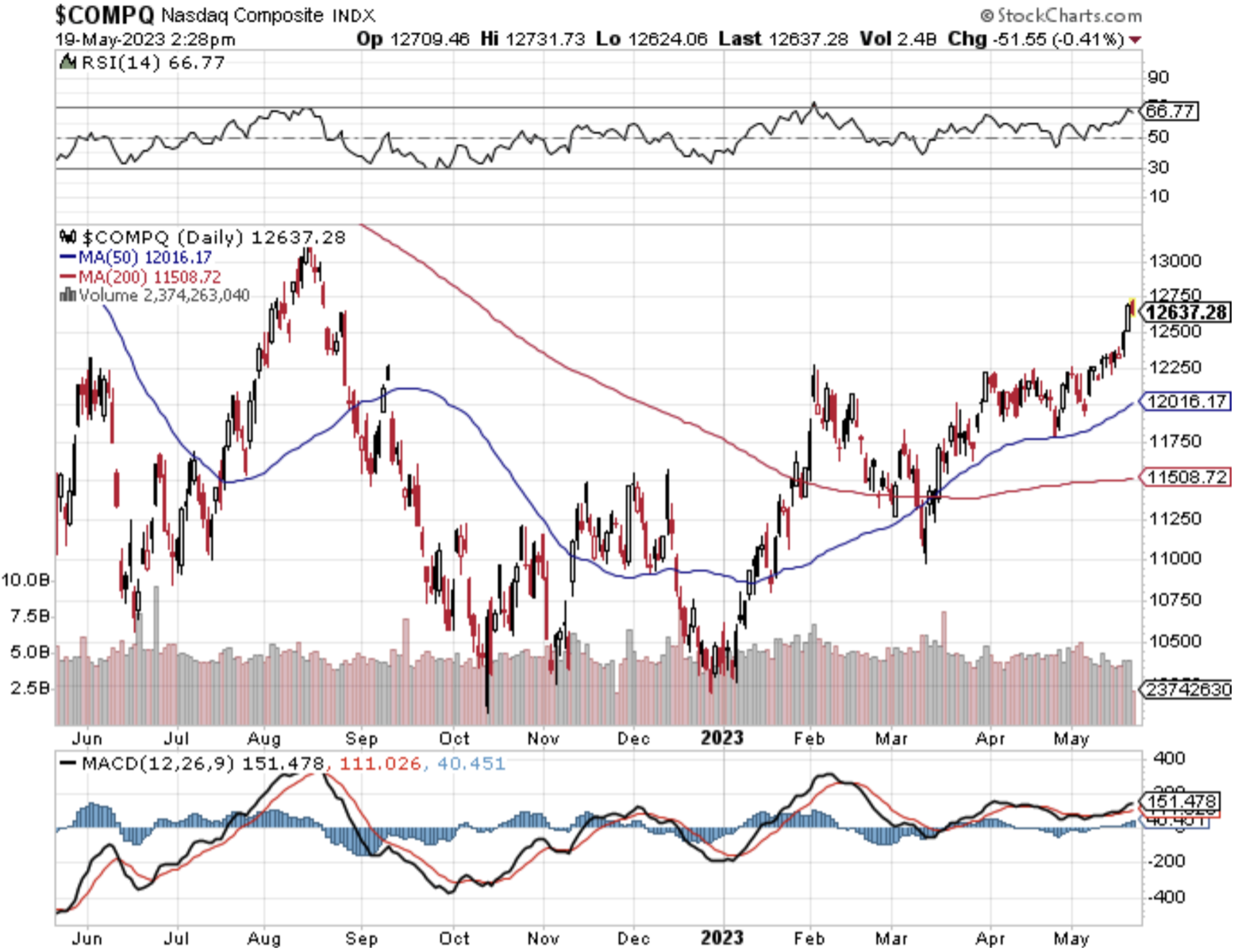
Legal Disclaimer
There is a very high degree of risk involved in trading. Past results are not indicative of future returns. MadHedgeFundTrader.com and all individuals affiliated with this site assume no responsibilities for your trading and investment results. The indicators, strategies, columns, articles and all other features are for educational purposes only and should not be construed as investment advice. Information for futures trading observations are obtained from sources believed to be reliable, but we do not warrant its completeness or accuracy, or warrant any results from the use of the information. Your use of the trading observations is entirely at your own risk and it is your sole responsibility to evaluate the accuracy, completeness and usefulness of the information. You must assess the risk of any trade with your broker and make your own independent decisions regarding any securities mentioned herein. Affiliates of MadHedgeFundTrader.com may have a position or effect transactions in the securities described herein (or options thereon) and/or otherwise employ trading strategies that may be consistent or inconsistent with the provided strategies.
This site uses cookies. By continuing to browse the site, you are agreeing to our use of cookies.
OKLearn moreWe may request cookies to be set on your device. We use cookies to let us know when you visit our websites, how you interact with us, to enrich your user experience, and to customize your relationship with our website.
Click on the different category headings to find out more. You can also change some of your preferences. Note that blocking some types of cookies may impact your experience on our websites and the services we are able to offer.
These cookies are strictly necessary to provide you with services available through our website and to use some of its features.
Because these cookies are strictly necessary to deliver the website, refuseing them will have impact how our site functions. You always can block or delete cookies by changing your browser settings and force blocking all cookies on this website. But this will always prompt you to accept/refuse cookies when revisiting our site.
We fully respect if you want to refuse cookies but to avoid asking you again and again kindly allow us to store a cookie for that. You are free to opt out any time or opt in for other cookies to get a better experience. If you refuse cookies we will remove all set cookies in our domain.
We provide you with a list of stored cookies on your computer in our domain so you can check what we stored. Due to security reasons we are not able to show or modify cookies from other domains. You can check these in your browser security settings.
These cookies collect information that is used either in aggregate form to help us understand how our website is being used or how effective our marketing campaigns are, or to help us customize our website and application for you in order to enhance your experience.
If you do not want that we track your visist to our site you can disable tracking in your browser here:
We also use different external services like Google Webfonts, Google Maps, and external Video providers. Since these providers may collect personal data like your IP address we allow you to block them here. Please be aware that this might heavily reduce the functionality and appearance of our site. Changes will take effect once you reload the page.
Google Webfont Settings:
Google Map Settings:
Vimeo and Youtube video embeds:
